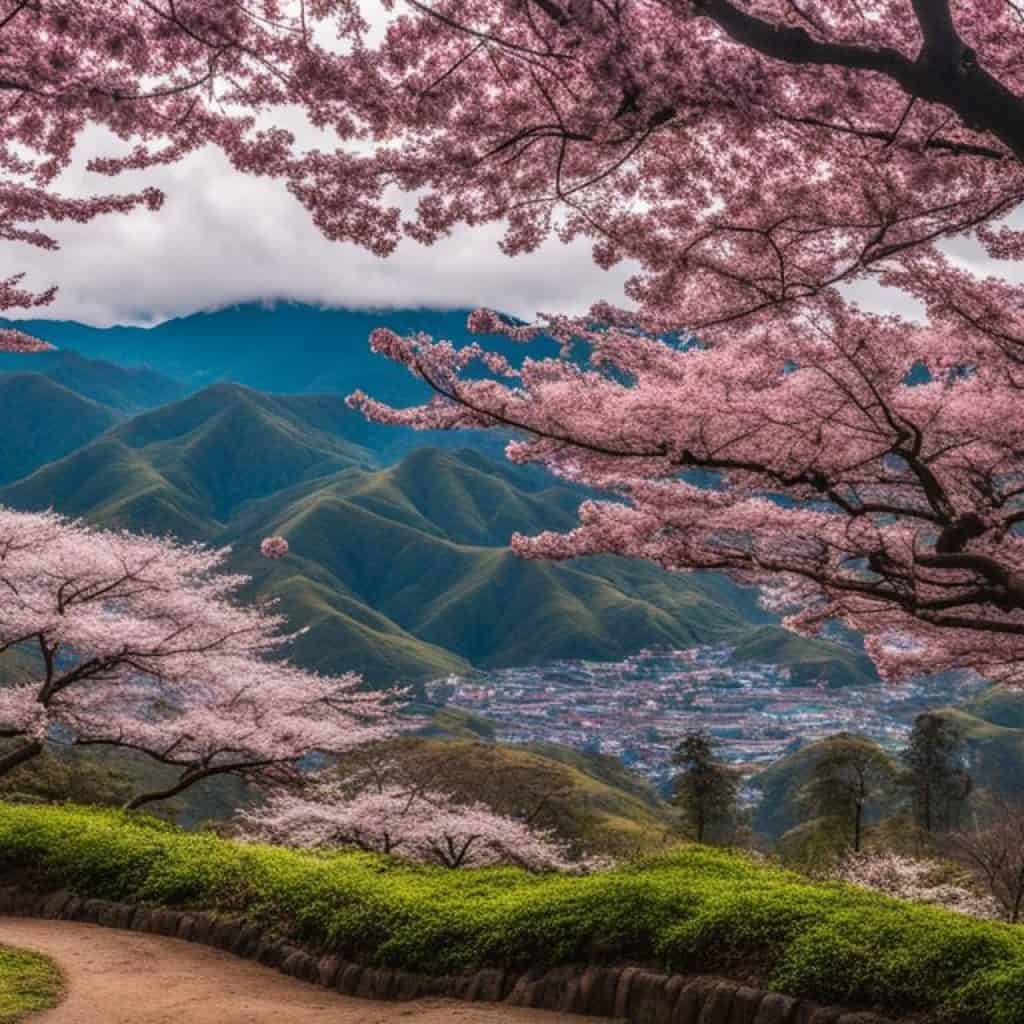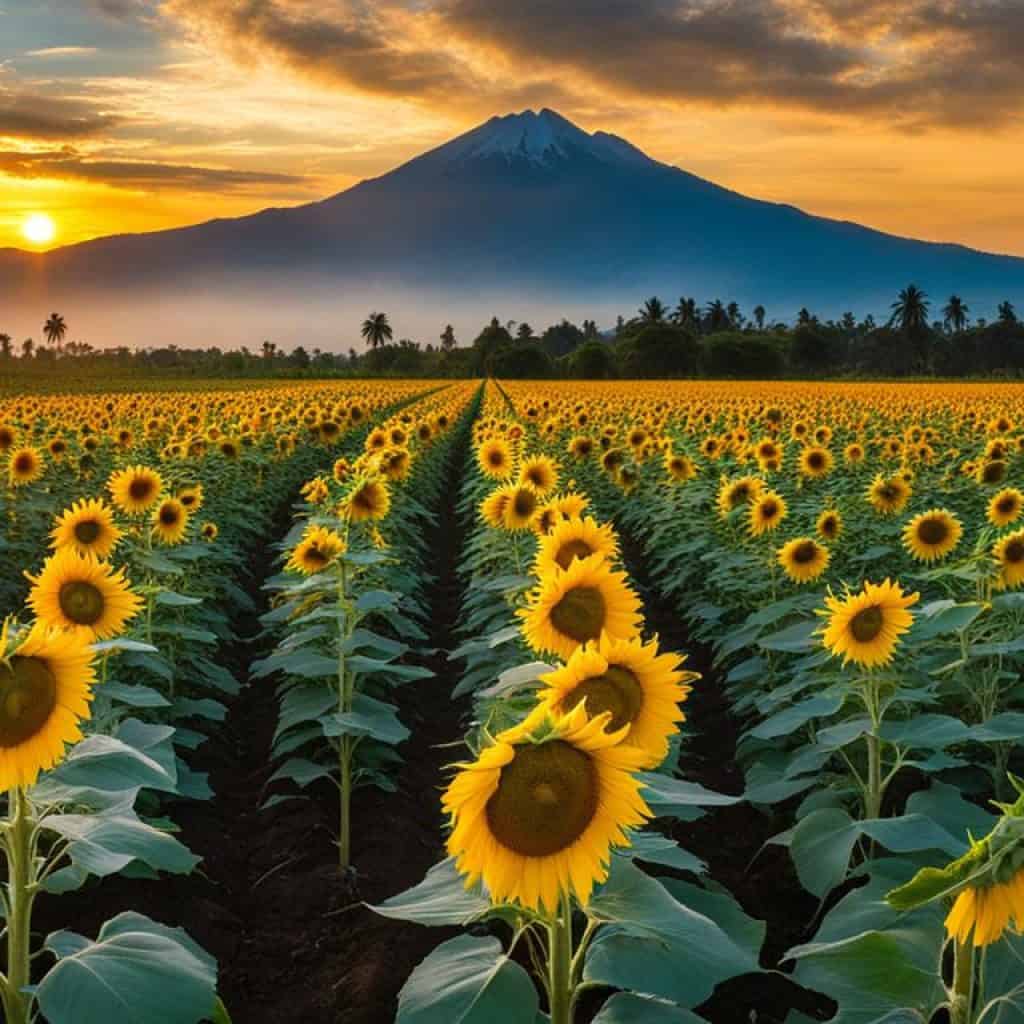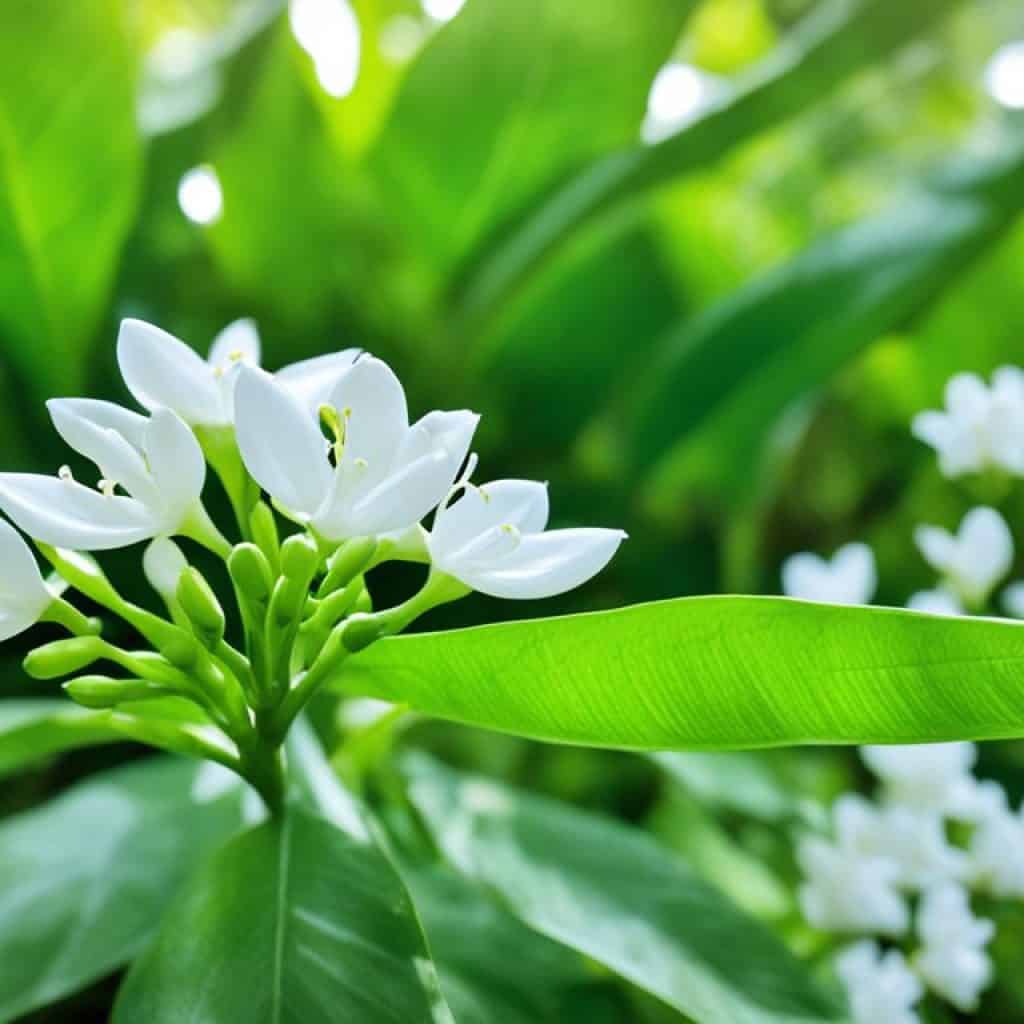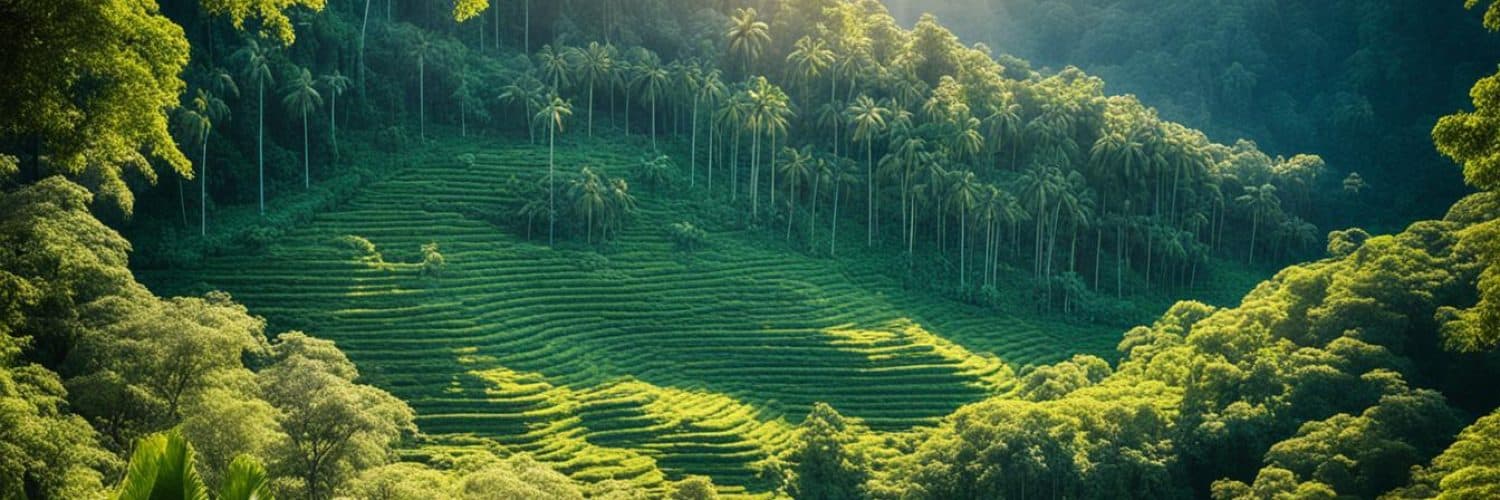Have you ever wondered about the vibrant floral tapestry that adorns the beautiful landscapes of the Philippines? From the lush tropical blooms to the rare and captivating native Philippine flowers, the country is an enchanting paradise for flower enthusiasts and nature lovers alike. But what are the popular flowering plants that make the Philippines’s floral heritage so unique? Are there any rare flowers that can only be found in the Philippines? Let’s embark on a journey through the blooming plants native to the Philippines and discover the mesmerizing beauty that awaits.
Key Takeaways:
- The Philippines is home to a diverse array of flowering plants that create a vibrant and colorful landscape.
- Popular flowering plants in the Philippines include the Sampaguita, Rafflesia, Rose Mallow, and many more.
- The country boasts rare flowers that can only be found within its borders, making it a haven for plant enthusiasts.
- Preserving the biodiversity of Philippine plant species is essential to maintain the natural beauty of the country.
- Exploring the native Philippine flowers is a wonderful way to appreciate the wonders of nature and foster a deeper connection to the environment.
Sunshine Farm (Quezon)
Sunshine Farm, located in Barangay Lai, Tiaong Quezon, is known for its thousands of sunflowers. It is a picturesque attraction and a favorite setting for special occasions like birthdays and weddings. The farm also has a meaningful cause, as it provides livelihood to disabled people and supports various PWD projects.
Celossian Flower Farm (Rizal)
The Celossian Flower Farm in Baras, Rizal is a captivating destination for flower enthusiasts and nature lovers. This picturesque farm is known for its vibrant display of celosia, a beautiful flower with flame-shaped petals in bright red and yellow colors. The celosia, also known as the woolflower or cockscomb, blooms once a year, creating a spectacle that is worth the wait.
The Celossian Flower Farm is nestled in the heart of Rizal, where it thrives in the country’s humid climate. The farm offers visitors a unique opportunity to witness the stunning beauty of these exotic flowers up close. Walking through the farm, you’ll be surrounded by a sea of celosia blooms, creating a picturesque and colorful landscape.
The Celossian Flower Farm is often compared to the flower farms in the Netherlands, known for their breathtaking tulip fields. Despite its fame, the Celossian Flower Farm maintains its accessibility, allowing visitors to experience the beauty of celosia without breaking the bank. With a minimal entrance fee, this farm is a budget-friendly option for those seeking a memorable floral experience.
Whether you’re a flower enthusiast or simply appreciate the beauty of nature, a visit to the Celossian Flower Farm in Rizal is an experience you don’t want to miss. Immerse yourself in the vibrant colors and unique shapes of the celosia flowers, and let their beauty inspire and uplift your spirits.
Haight’s Place Sakura Park (Benguet)
Experience the enchanting beauty of cherry blossoms in the Philippines at Haight’s Place Sakura Park in Atok, Benguet. This picturesque park, located amidst the lush scenery of hilly landscapes, is a must-visit destination for flower enthusiasts and nature lovers.
As you stroll through the park, you’ll be mesmerized by the delicate pink and white flowers of the Sakura trees. These stunning trees were generously donated by Japan, adding a touch of Japanese charm to the park. The two varieties of Sakura, Yakiwari Sakuta and Sindaya Sakura, create a breathtaking display of color and elegance.
While the Sakura trees are still maturing, Haight’s Place Sakura Park offers more than just cherry blossoms. Explore the park’s cool weather flowers, including vibrant hydrangeas, cheerful sunflowers, and cheerful calendulas. The combination of these cool-weather blooms and the hilly landscapes creates a picturesque setting that is perfect for capturing unforgettable photos.
Visiting Information:
- Location: Atok, Benguet
- Opening Hours: 8:00 AM to 5:00 PM
- Entrance Fee: PHP 50 per person
Don’t miss the opportunity to immerse yourself in the beauty of Haight’s Place Sakura Park Benguet. It’s a serene escape where you can witness the magic of cherry blossoms in the heart of the Philippines.

Farmer’s Love Agri Farm (Tarlac)
Explore the enchanting flower fields of Tarlac at Farmer’s Love Agri Farm. Nestled on half a hectare of land, this picturesque farm is a vibrant paradise of colors. From March to May, when the flowers are in full bloom, the farm showcases a magnificent display of marigolds, celosias, vinca, and zinnia flowers.
Known as the “Little Amsterdam of Tarlac,” Farmer’s Love Agri Farm invites visitors to immerse themselves in the beauty of its blooming landscape. Stroll through the fields, basking in the breathtaking sights and intoxicating scents of the flowers. This farm captures the essence of the world-renowned Keukenhof Garden in Amsterdam but with a unique Filipino twist.
Whether you’re a flower enthusiast, nature lover, or simply seeking tranquility, Farmer’s Love Agri Farm promises an unforgettable experience. The meticulously arranged flower fields provide a serene backdrop for capturing stunning photos or indulging in quiet contemplation amidst nature’s wonders.
Experience the Beauty of Tarlac’s Flower Fields
Visiting Farmer’s Love Agri Farm is a sensory delight. See the vibrant hues of marigolds, the intricate petals of celosias, the delicate blossoms of vinca, and the charming zinnia flowers that add pops of color to the landscape.
“The fields at Farmer’s Love Agri Farm are a true feast for the senses. The explosion of colors and the sweet fragrance of these flowers create a magical ambiance that uplifts the spirit.” – Flower Enthusiast
When you step into this floral sanctuary, you’ll be captivated by the perfectly manicured rows of flowers extending as far as the eye can see. It’s an enchanting sight that guarantees to leave a lasting impression.
Plan Your Visit
To make the most of your visit to Farmer’s Love Agri Farm, plan your trip between March and May. During this time, the flowers are at their peak, showcasing their vibrant blooms in all their glory. The farm opens its doors to visitors who want to escape the hustle and bustle of city life and immerse themselves in the serenity of nature.
Take your time exploring the farm, meandering through the flower fields, and enjoying the breathtaking views. Don’t forget to bring your camera to capture the beauty that surrounds you.
Experience the magic of Tarlac’s flower fields at Farmer’s Love Agri Farm. Immerse yourself in the colors, scents, and tranquility of this breathtaking paradise.
Yamato Flower Farm (Iloilo)
Discover the hidden gem of flower farms in the Visayas region at Yamato Flower Farm in Lambunao, Iloilo. This unassuming yet extraordinary farm spans over two hectares of picturesque land, offering a serene oasis for flower enthusiasts and nature lovers.
At Yamato Flower Farm, you’ll be captivated by a diverse collection of flowering plants, including the vibrant and enchanting portulaca flowers, the delicate and graceful cosmos flowers, the colorful and cheerful zinnia flowers, and the radiant and aromatic marigold flowers. Immerse yourself in a kaleidoscope of colors as you stroll through the fields of blooming wonders.
Experience Tranquility in Nature’s Embrace
The farm’s primary goal is to provide a peaceful and relaxing environment where visitors can connect with nature. Surrounded by the beauty and fragrance of the flowers, you’ll find tranquility and a sense of calm that rejuvenates the soul.
“Yamato Flower Farm is a true haven for those seeking solace and serenity amidst nature’s bounty.” – Flower Enthusiast Magazine
Take a leisurely walk along the well-maintained paths and immerse yourself in the idyllic scenery. Let the gentle breeze caress your skin as you admire the colorful blooms dancing in harmony. Yamato Flower Farm offers an escape from the hustle and bustle of the city, allowing you to reconnect with the beauty of the natural world.
Visiting Yamato Flower Farm
Yamato Flower Farm is open to the public year-round, providing an opportunity to experience the ever-changing beauty of nature in every season. Whether you visit during the vibrant burst of summer blooms or the serene tranquility of a winter garden, you’ll be greeted by breathtaking vistas at every turn.
Be sure to check the farm’s website for seasonal events and workshops, where you can deepen your knowledge of flowers and gardening techniques. Join a guided tour to learn more about the different flower varieties and gain valuable insights from experienced horticulturists who manage the farm.
Plan Your Visit to Yamato Flower Farm
When planning your trip to Iloilo, make sure to include Yamato Flower Farm in your itinerary. Immerse yourself in the beauty of nature and experience the tranquility that only a flower farm in Visayas can offer.
To get an idea of the stunning sights that await you, take a glimpse at the image below:
| Flower Varieties | Highlights |
|---|---|
| Portulaca Flowers | A wide range of vibrant colors and delicate petals |
| Cosmos Flowers | Elegant and graceful blooms that sway gently in the breeze |
| Zinnia Flowers | Bright and colorful flowers that attract butterflies and bees |
| Marigold Flowers | Radiant hues and a lovely fragrance that symbolize positivity and happiness |
Prepare to be enchanted by the wonders of Yamato Flower Farm. Lose yourself amidst the vibrant colors, delicate fragrances, and serene atmosphere of this hidden gem in Iloilo. A visit to Yamato Flower Farm promises to be a truly transformative experience, leaving you with cherished memories and a deep appreciation for the beauty of nature’s bounty.
Mariano’s Blooming Agri-Tourism Park (South Cotabato)
Mariano’s Blooming Agri-Tourism Park, located in Tupi, South Cotabato, is a remarkable destination for nature-lovers and flower enthusiasts. The park is famed for its breathtaking sunflower field, showcasing over 10,000 sunflowers meticulously planted in symmetrical rows. As you wander through the expansive field, you’ll be greeted by vibrant flower patterns, as the sunflowers tilt their sunny faces towards the sky.
But the beauty doesn’t end there. Mariano’s Blooming Agri-Tourism Park also boasts a diverse array of other flower varieties. From delicate cosmo flowers to vibrant marigolds and elegant carnations, the park’s floral collection offers a captivating feast for the eyes. The meticulously curated flower beds create a tapestry of colors, showcasing the natural beauty of these exquisite blooms.

The park provides a picturesque setting for photographers and visitors alike. Capture stunning photos amidst the golden sea of sunflowers or relax at the park’s viewing deck for a breathtaking panoramic view of the surrounding scenery. It’s an idyllic spot to immerse yourself in nature’s beauty and find peace in the vibrant blooms that surround you.
Endangered Philippine Vine at WNMU Greenhouse
The Western New Mexico University (WNMU) greenhouse is home to a captivating and endangered turquoise jade vine plant from the Philippines. Known scientifically as Strongylodon macrobotrys, this vine plant is a rare and beautiful sight. It was first discovered by Western explorers in 1841, highlighting its historical and botanical significance.
The WNMU greenhouse offers a unique opportunity for visitors to witness the rare blooms of the turquoise jade vine and explore other tropical wonders and plants. Open to the public, the greenhouse is a sanctuary for preserving endangered species and promoting environmental awareness.
Turquoise Jade Vine: A Botanical Treasure
The turquoise jade vine, also known as Strongylodon macrobotrys, is a rare and endangered plant species native to the Philippines. Its breathtaking turquoise-colored flowers cascade down from high branches, creating a mesmerizing display of color and beauty. The vine’s vibrant blooms, coupled with its delicate foliage, make it a sought-after gem for plant enthusiasts and conservationists.
“The turquoise jade vine is a testament to the incredible biodiversity found in the Philippines. It serves as a reminder of the importance of preserving endangered plant species and their natural habitats.” – Dr. Botanist, Conservation Biologist
The WNMU greenhouse plays a crucial role in safeguarding the turquoise jade vine and raising awareness about the importance of conservation. It offers an educational experience for visitors, allowing them to witness firsthand the allure and fragility of this endangered vine.
The WNMU Greenhouse: A Haven for Tropical Wonders
More than just a home for the turquoise jade vine, the WNMU greenhouse is a sanctuary for various tropical plants from around the world. Its lush and carefully curated collection showcases the beauty and diversity of tropical flora, providing visitors with a serene and educational experience.
Visitors to the WNMU greenhouse can explore the vibrant tropical landscape, learn about plant conservation efforts, and gain a greater appreciation for the interconnectedness of nature. From exotic orchids to towering palms, every corner of the greenhouse is a testament to the incredible biodiversity found on our planet.
| Features of WNMU Greenhouse: | Highlights |
|---|---|
| Endangered Plant Species | Preservation and conservation efforts |
| Rare and Exotic Tropical Plants | Visually stunning and educational |
| Expert Guidance and Information | Engaging tours and knowledgeable staff |
| Interactive Exhibits | Hands-on learning experiences |
Whether you’re a budding botanist, nature enthusiast, or simply looking for a peaceful escape, the WNMU greenhouse offers a captivating experience like no other. Step into a world of tropical wonders and be inspired by the beauty and fragility of the natural world.
Native Wildflowers of the Philippines
The Philippines is a treasure trove of native wildflowers, showcasing the natural beauty and biodiversity of its floral landscape. From vibrant and colorful blooms to rare and endemic species, these wildflowers are a testament to the country’s rich and diverse ecosystem.
When exploring the Philippine wilderness, one can encounter a variety of enchanting native flowers. Here are some of the remarkable wildflowers that grace the Philippine countryside:
- Sampaguita: The Sampaguita, scientifically known as Jasminum sambac, is the national flower of the Philippines. This small, white, and delicately fragrant flower holds deep cultural significance and symbolizes purity, simplicity, and national pride. Often used in making garlands and offered as a sign of respect, Sampaguita is cherished by Filipinos nationwide.
- Rafflesia: Known as the “Corpse Flower,” the Rafflesia is a rare and captivating wildflower found in the Philippines. With its massive petals and unique odor resembling rotting flesh, it is truly a sight to behold. This endangered species is a testament to the country’s natural wonders and the need for its conservation.
- Rose Mallow: The Rose Mallow, or Hibiscus moscheutos, is a tall and showy wildflower that thrives in wetland areas. Its large and vibrant flowers, reaching up to six inches in diameter, make it a striking addition to the picturesque Philippine landscape. These flowers not only add beauty but also attract pollinators, contributing to the sustainability of local ecosystems.
- Waling Waling Orchid: The Waling Waling, scientifically known as Euanthe sanderiana, is considered one of the most beautiful orchids in the world. Endemic to the Philippines, this rare orchid blooms with vibrant colors and intricate patterns. It is highly sought after by orchid enthusiasts and represents the country’s floral diversity.
- Tayabak: The Tayabak, also known as Dendrobium anosmum, is an enchanting orchid species found in the Philippines. With its cascading clusters of flowers and delicate fragrance, it adds elegance to the Philippine flora. This endemic orchid is treasured for its beauty and resilience.
These native wildflowers of the Philippines not only contribute to the aesthetic beauty of the country but also play a vital role in preserving its biodiversity. It is essential to appreciate and safeguard these natural wonders to ensure their preservation for future generations.
Sampaguita: The Fragrant National Flower
Sampaguita, scientifically known as Jasmine sambac, holds the esteemed title of the national flower of the Philippines. This small white flower with a captivating scent is deeply embedded in Filipino traditions and symbolizes purity, simplicity, humility, and strength. The fragrance of Sampaguita is used in making garlands worn during special occasions and religious ceremonies, fostering a sense of unity and national pride.

Throughout Philippine history, Sampaguita has played a significant role in the cultural tapestry of the nation. Known for its delicate beauty and enchanting fragrance, this native flower has become a symbol of national pride and identity.
“Sampaguita, with its elegant simplicity, represents the essence of Filipino culture. It embodies the values of purity and humility, reminding us to stay grounded in our roots and to embrace the beauty within ourselves and others.”
Traditionally, Sampaguita garlands, also known as “lei,” are worn during important events such as weddings, graduations, and religious ceremonies. These fragrant garlands symbolize love, respect, and goodwill. From brides walking down the aisle adorned with Sampaguita garlands to religious processions where the faithful offer them to statues of saints, the presence of this flower brings a sense of purity and reverence.
In addition to its cultural significance, Sampaguita also holds a special place in the hearts of many Filipinos as a reminder of their homeland when living abroad. It serves as a nostalgic connection to the Philippines, evoking memories of home and generating a sense of national identity.
Sampaguita: Symbolism and Significance
The significance of Sampaguita can be traced back to its name, derived from the Tagalog words “sumpa kita” meaning “I promise you.” This name reflects the promise of love, sincerity, and commitment inherent in this exquisite flower. It represents the Filipino spirit and the values deeply ingrained in Filipino culture.
The simplicity of Sampaguita’s appearance is a testament to its cultural symbolism. Its unassuming white petals signify the purity and innocence that should be cherished and protected. The flower’s resilience in harsh conditions serves as a reminder of the strength and resilience of the Filipino people.
“Sampaguita, with its delicate beauty and captivating fragrance, reminds us to find beauty and joy in simplicity. It teaches us to appreciate the small things in life that bring happiness and contentment.”
As the national flower of the Philippines, Sampaguita represents not only the natural beauty of the country but also the enduring spirit and unity of its people. This flower embodies the Filipino values of hospitality, warmth, and kindness, serving as a cultural ambassador whenever it is worn or gifted.
| Cultural Significance | Symbolism |
|---|---|
| Worn as garlands during special occasions and religious ceremonies | Representing love, respect, and goodwill |
| Nostalgic connection to the Philippines for Filipinos living abroad | Eliciting memories of home and fostering a sense of national identity |
| Sampaguita’s name derived from “sumpa kita” (I promise you) | Symbolizing love, sincerity, and commitment |
| Purity and simplicity reflected in the unassuming white petals | Signifying purity, innocence, and resilience |
Sampaguita is more than just a flower; it is a symbol of the Philippines and the values that define its people. Through its cultural significance and cherished symbolism, Sampaguita continues to inspire and unite Filipinos, forming an integral part of the country’s vibrant heritage.
Rafflesia: The Corpse Flower
The Rafflesia, also known as the Corpse Flower, is a fascinating and unique endemic flower found in the Philippines. This rare sight is known for its giant petals, measuring up to 80 cm in diameter, making it one of the largest flowers in the world.
What sets the Rafflesia apart is its distinct odor, often described as similar to rotting flesh. This pungent smell attracts carrion flies, which aid in pollination. Despite its unpleasant scent, the Rafflesia’s beauty is undeniable, with giant red petals adorned with white spots, creating a captivating and distinct appearance.
The Rafflesia is considered endangered due to its limited distribution and habitat destruction. The flower’s unique lifecycle adds to its rarity, as it spends most of its life hidden within the roots of its host plant, only emerging to bloom for a few days.
“The Rafflesia is a true wonder of nature, with its gigantic size and remarkable features. Despite its rotting odor, the flower’s beauty and rarity make it a sight worth experiencing for nature enthusiasts.” – Dr. Botanist
Interesting Facts about Rafflesia:
- The Rafflesia is named after Sir Thomas Stamford Raffles, the British governor who discovered the flower in the early 19th century.
- It is considered a parasitic plant, relying on its host plant for nutrients.
- Rafflesia flowers have no leaves, stems, or roots, making the flower itself the only visible part of the plant.
- The blooming process of the Rafflesia can take up to a year, with the flower gradually growing in size before finally opening up.
Rafflesia in the Philippines
The Philippines is home to several species of Rafflesia, with the largest concentration found in the island of Luzon. The flower’s limited distribution and elusive nature make spotting a blooming Rafflesia a truly special and rare experience for nature enthusiasts.
| Rafflesia Species | Location | Blooming Season |
|---|---|---|
| Rafflesia manillana | Mount Makiling, Laguna | December to February |
| Rafflesia schadenbergiana | Mount Banahaw, Quezon | January to March |
| Rafflesia speciosa | Mount Apo, Mindanao | Year-round (with peak blooming in March to May) |
Exploring the lush forests and hiking trails of the Philippines can offer adventurous individuals the opportunity to catch a glimpse of this magnificent flower. However, it is important to remember that the Rafflesia is a protected species, and its preservation should always be prioritized.
Witnessing the blooming of a Rafflesia is like encountering a hidden treasure, a testament to the incredible diversity and natural wonders the Philippines has to offer.
Rose Mallow: Beauty in Wetlands
Rose Mallow, scientifically known as Hibiscus moscheutos, is a tall and showy wildflower that flourishes in wet environments such as wetlands, marshes, and riverbanks. With its strikingly large flowers reaching up to 6 inches in diameter, Rose Mallow adds a captivating charm to any landscape.
This wetland flower not only brings beauty to its surroundings but also plays a crucial role in supporting local ecosystems. Rose Mallow attracts pollinators such as bees, butterflies, and hummingbirds, making it a favorite among gardeners and nature enthusiasts. Its nectar-rich blossoms serve as a beacon, enticing these pollinators to visit and spread pollen, ensuring the survival and diversity of various plant species.
Furthermore, Rose Mallow has practical uses beyond its aesthetic appeal. The leaves and roots of this flowering plant are utilized in the production of herbal teas, adding a delicate and soothing touch to these natural brews. The herbal teas derived from Rose Mallow are not only relaxing but also offer potential health benefits due to the presence of bioactive compounds.
To give you a visual appreciation of this wetland beauty, take a look at the image below:
Embrace the beauty and ecological value of Rose Mallow by incorporating this enchanting wetland flower into your landscape or garden. Whether it’s attracting pollinators, enjoying herbal teas, or simply admiring its majestic blooms, Rose Mallow is a wonderful addition that celebrates nature’s diversity.
Conclusion
The Philippines is home to a vibrant floral heritage, with an abundance of flowering plants that showcase the country’s natural beauty and diverse ecosystems. From the picturesque flower farms to the enchanting native wildflowers, there is no shortage of blooming wonders to explore and appreciate.
Preserving the biodiversity of these flowering plants is vital for the future generations to continue experiencing the splendor and benefits they provide. By maintaining and protecting the natural habitats of these plants, we can ensure their survival and contribute to the conservation of the Philippine flora.
Through our appreciation for the beauty of these flowering plants in the Philippines, we develop a deeper connection with nature. The vibrant colors, intricate patterns, and delicate fragrances remind us of the inherent beauty and harmony that exists in the natural world. Let us continue to nurture a love and respect for nature’s creations and work together to preserve the ecological balance.
As we marvel at the breathtaking displays of vibrant floral landscapes, let us not forget our responsibility to be stewards of the environment. By understanding, valuing, and protecting the multitude of flowering plants in the Philippines, we can ensure that future generations will have the opportunity to experience and be inspired by nature’s beauty.


















Add comment